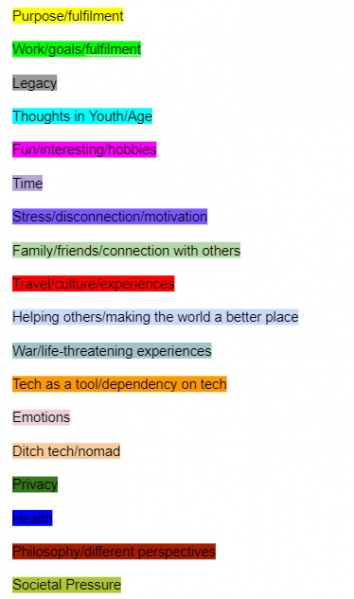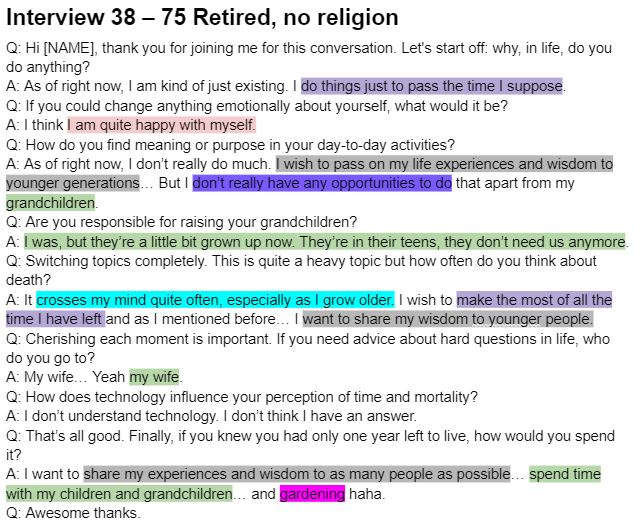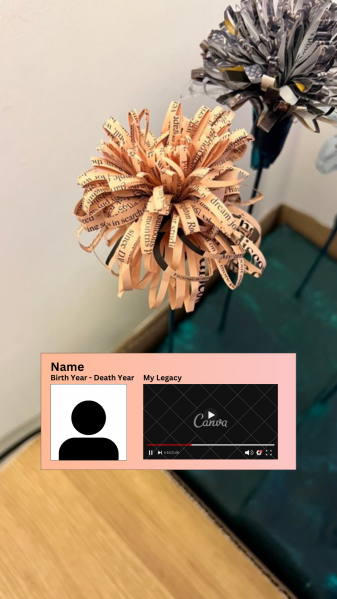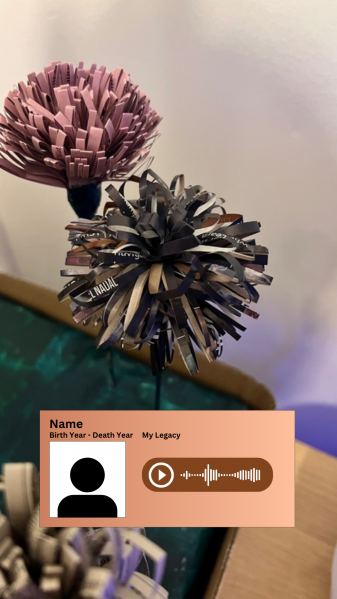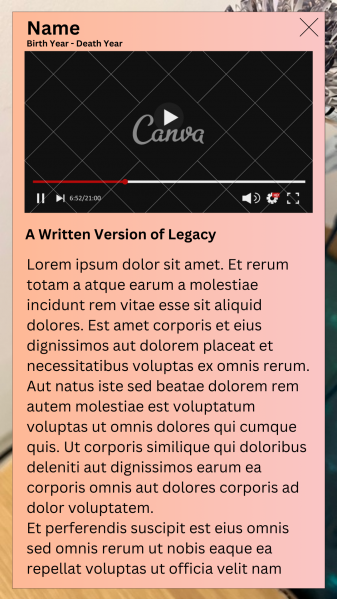Bloom
In a world brimming with distractions, the challenge of living meaningfully and leaving a lasting legacy was discovered as a problem space. Recognizing this, my group aimed to facilitate the preservation and sharing of personal legacies through an innovative and meaningful approach. Introducing Bloom: an interactive, augmented reality (AR) experience designed for cemeteries.
Bloom transforms traditional memorials by integrating artificial flowers with AR technology. Each flower, linked to a deceased individual's legacy, can be scanned using a smartphone app to reveal a curated collection of videos, audio recordings, photos, and text left by the departed. This interactive feature not only offers a profound way to remember loved ones but also provides a reflective space for visitors.
Our goal is to enable individuals nearing the end of their lives to leave a meaningful imprint and to provide a contemplative resource for those grappling with their own sense of purpose. By utilising flowers as the medium, Bloom preserves the serene atmosphere of cemeteries while offering a modern, immersive experience. This thoughtful blend of technology and tradition aims to create a lasting impact, honouring legacies and enriching the experiences of all who visit.
This group project was created as part of a course assessment at the University of Queensland. Although being heavily involved throughout the design process, my main contributions to this project included interview analysis, ideation and prototyping. Due to members of the team (including myself) becoming increasingly passionate about this project, we have decided to continue with it outside of university.
My Main Contributions
Interview Analysis
Phase 1: Initial Stakeholder Interviews
All team members conducted initial interviews to gain insight into our problem space, focusing on death as a motivator at this project stage. These interviews aimed to gather various perspectives from people of different ages, genders, and religions, which would help us identify stakeholders and narrow down our project's focus. After everyone completed their interviews, I was responsible for the interview analysis for the report. For my section, I conducted a thematic analysis of the interviews, looking over the data to identify reoccurring themes and patterns. I started by reading each transcript and highlighting quotes corresponding to specific themes in different colours. This can be seen in the example images below.
I also took note of any interesting quotes for future reference. Once I completed this, I made a Miro board with relevant quotes grouped into their themes to refer to while creating the interview analysis. An example of this can be seen in the image below.
I then decided on the most significant themes for our solution, discussing in the report analysis why these themes and quotes were valuable for our project process.
The interview analysis was a highly significant part of the project, as the themes and quotes uncovered from the interviews revealed a different focus area than initially thought. Based on our background research, we planned to focus on using death as a motivator for young people, encouraging them to live life to the fullest by reminding them of their mortality. However, after I completed the interview analysis, I found contradicting evidence: people preferred a more balanced approach to contemplating their mortality rather than being constantly reminded of their limited time. These findings were highly significant for our project as they completely changed our focus from confronting people with their mortality to prompting them to reflect on their mortality meaningfully.
Additionally, I uncovered a new solution space focused on older people's desire to leave a legacy and help others through their advice. These findings were a pivotal part of our project, providing us with the exciting concept of helping older people share and immortalise their legacy while offering those struggling to find purpose in their lives the chance to gain insights from those wiser than them. Overall, the interview analysis for this round of interviews was a valuable part of the project. It allowed us to analyse personal insights about our problem space, which informed the iteration of our potential solutions, shifting our project's focus from motivating youth to immortalising people's legacies.
Phase 2: Nurse Interviews
For the second phase of interviews, specifically with nurses working in aged care, I was again in charge of analysing the data. In this analysis, I adopted a similar strategy to the initial interviews by going through the transcripts and highlighting common themes. In contrast, however, I decided to read over all of the interviews once before deciding on themes and beginning to highlight them. This was a more effective strategy to adopt as I had a clearer idea of what information I had available and possible themes within the data before highlighting them. It was especially beneficial as my teammate Jacky conducted the interviews, meaning I needed to familiarise myself with the responses and understand what interviewees said to analyse them.
The interviews with professionals working in aged care were fascinating as they reinforced and elaborated on the concepts of legacy highlighted in previous interviews. This correlation between the two rounds of interviews that I discovered through analysis was vital in developing our project. They cemented our understanding of the need to leave a legacy behind as a real problem space with the possibility of human-centred solutions. Before these findings, we were unsure if a solution space existed in providing motivation and purpose to individuals through the theme of death; however, with my analysis of interviews, we knew for sure that we could create a meaningful and motivating solution that takes into account the legacies of the deceased and the lack of purpose in young people.
Reflection
Although the interview analysis uncovered plenty of helpful information, there are still improvements that I could make to my work. Firstly, I would ensure that two interviewees are present during the interviewing process. One would ask the questions, and the other would take notes. This method ensures we uncover more mannerisms, emotional responses and emerging themes. Notes about the interviewee's physical reactions would be particularly useful as I used them less than I would have liked in this analysis due to limited information.
Furthermore, as previously discussed, I would complete an initial readthrough of all interview transcripts before deciding on themes and beginning to highlight them. I did not do an initial readthrough in the first round of interviews due to the sheer number of pages to read. However, when completing the analysis of nurse interviews, it was advantageous to read through each transcript and take notes on potential themes and valuable information before deciding on final themes and highlighting them. An initial readthrough ensures that the chosen themes are relevant and specific to the domain, benefiting in a more nuanced analysis.
Ideation and Prototyping
Ideation
During the final ideation stages of our project, we tried to come up with an idea that would fit the conceptual criteria we created. The solution had to successfully preserve and present the legacies of the deceased while also being suitable for a cemetery context, among other criteria. We also specifically wanted anyone to be able to have a Bloom flower despite their burial type. My team's main hurdle while ideating was developing a unique interaction method that ticked off all the conceptual criteria. It was a high priority for us not to create a mobile or web application but to integrate the solution into the physical context of cemeteries; we wanted to encourage users to explore and commemorate individuals around the graveyard while interacting with our solution. We worked as a team for much of this ideation phase, discussing possible solutions and building upon each other's ideas. I suggested using augmented reality (AR) in our solution, where people can go up to specific objects and look at them with their cameras to view people's legacies. I first suggested we implement this using a wall of scannable stars with connected constellations of family members. However, we decided that this could be messy and that flowers fit into the context space much better. Eventually, we also iterated on the idea so that the scannable flowers were not on a wall but scattered throughout the cemetery in flower beds, on gravestones, on columbaria and more.
This ideation stage was a significant part of our project. During this time, we finalised our concept based on our findings throughout the semester. We had to have an excellent final concept, as this is where we provided stakeholders with a possible solution to the problem space. The solution had to be relevant and account for stakeholders' needs and requests. We came up with a good solution that accounted for the needs and wants of all stakeholders involved. I contributed significantly to this process, critically reflecting on and expanding upon everyone's ideas to ensure we achieved a truly meaningful interaction experience for users. I also put forward a new interaction method that we had not previously considered (augmented reality), allowing us to create the exploratory and context-specific solution we needed. I am glad that we worked together as a team for this final stage of ideation, as we could generate various ideas that we would not have achieved by ideating individually, allowing us to land on an excellent and unique idea.
Prototype
After finalising our idea, I was responsible for creating a simple physical prototype of our solution to help explain our concept at our assessed exhibit. I needed to make this prototype to demonstrate the intended interaction and experience to visitors. I created the flowers from magazine pages and skewers, shredding the paper and wrapping it around the stick with tape. I then stuck these flowers into a fake flowerbed I created using cardboard, painted magazine pages, and foam.
To make the example user interface, I took pictures of the flowers I made and added a simple overlay using Canva to show what the legacy pop-up might look like.
Despite being made at the last minute, this prototype was well constructed and looked visually appealing, demonstrating my skills in prototyping. This prototype was crucial to communicating our idea effectively and helped our exhibit setup look beautiful overall. By creating the prototype, I provided a tangible version of our project's vision, allowing us to effectively share and demonstrate the intended interaction and experience along with the other exhibit materials made by my teammates.
Reflection
Our final concept was conceived using a suitable ideation method. However, if I were to do this again, I would investigate existing solutions in the field to obtain another perspective on top of the team's.
Our prototype would benefit from user testing and further iterating upon the design to best suit stakeholders and fit into a cemetery context. Although we think this solution will be effective, we can only know once we introduce it to stakeholders so they can interact with the system and provide feedback. Although I am happy with the physical flowerbed aspect of the prototype, I would ensure that the AR elements on the phone looked more aesthetically pleasing and professional, possibly giving multiple user interface options to explore and gain feedback from individuals visiting our exhibit. To do this I would assign myself more time to complete the UI elements and try out different layout, colour palettes and fonts to see which would fit our domain and intended experience best. I would also integrate the prototype into augmented reality rather than simulating the interaction with photos. It could also be interesting to add some form of animation to how the legacy appears to make it more visually appealing and add interest to the AR interaction.


